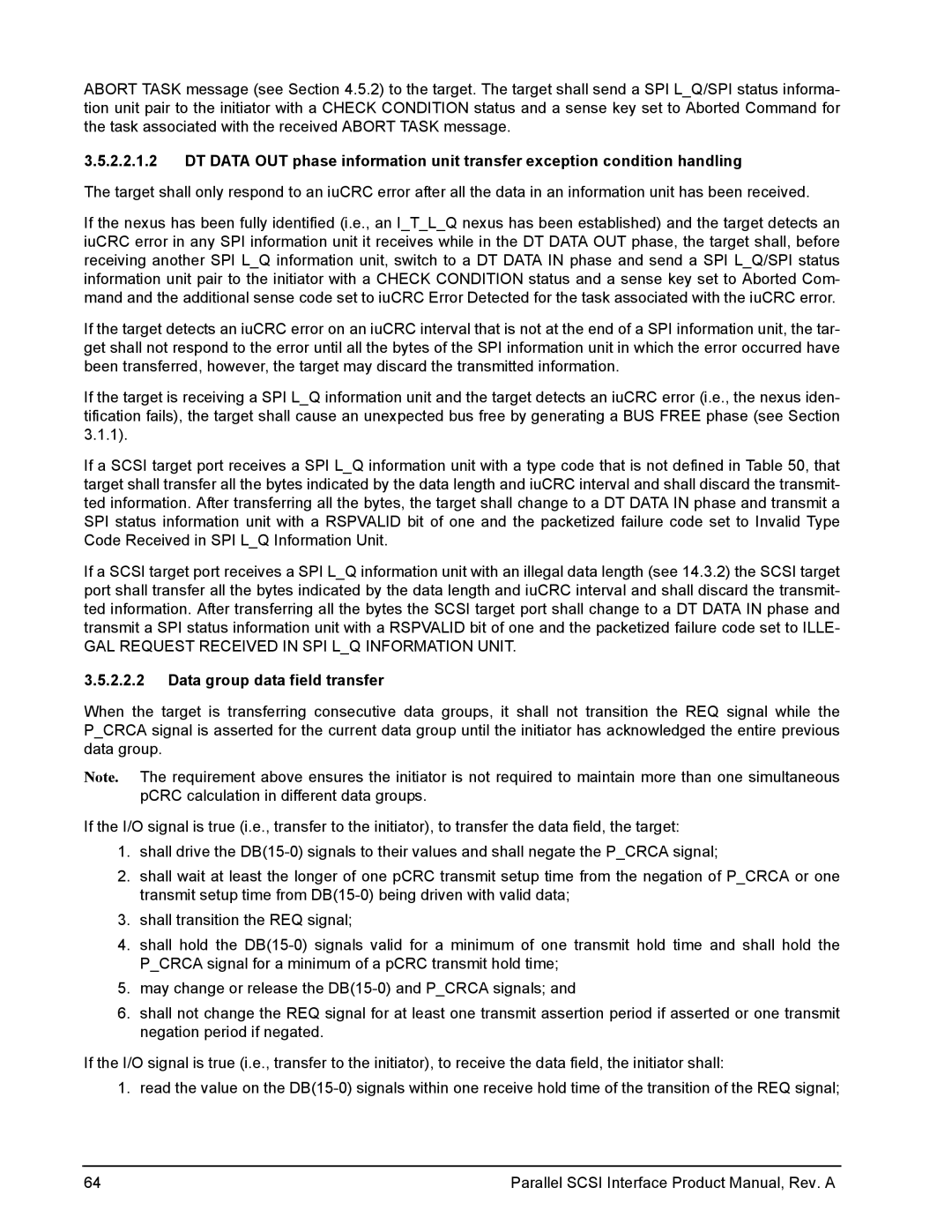ABORT TASK message (see Section 4.5.2) to the target. The target shall send a SPI L_Q/SPI status informa- tion unit pair to the initiator with a CHECK CONDITION status and a sense key set to Aborted Command for the task associated with the received ABORT TASK message.
3.5.2.2.1.2DT DATA OUT phase information unit transfer exception condition handling
The target shall only respond to an iuCRC error after all the data in an information unit has been received.
If the nexus has been fully identified (i.e., an I_T_L_Q nexus has been established) and the target detects an iuCRC error in any SPI information unit it receives while in the DT DATA OUT phase, the target shall, before receiving another SPI L_Q information unit, switch to a DT DATA IN phase and send a SPI L_Q/SPI status information unit pair to the initiator with a CHECK CONDITION status and a sense key set to Aborted Com- mand and the additional sense code set to iuCRC Error Detected for the task associated with the iuCRC error.
If the target detects an iuCRC error on an iuCRC interval that is not at the end of a SPI information unit, the tar- get shall not respond to the error until all the bytes of the SPI information unit in which the error occurred have been transferred, however, the target may discard the transmitted information.
If the target is receiving a SPI L_Q information unit and the target detects an iuCRC error (i.e., the nexus iden- tification fails), the target shall cause an unexpected bus free by generating a BUS FREE phase (see Section 3.1.1).
If a SCSI target port receives a SPI L_Q information unit with a type code that is not defined in Table 50, that target shall transfer all the bytes indicated by the data length and iuCRC interval and shall discard the transmit- ted information. After transferring all the bytes, the target shall change to a DT DATA IN phase and transmit a SPI status information unit with a RSPVALID bit of one and the packetized failure code set to Invalid Type Code Received in SPI L_Q Information Unit.
If a SCSI target port receives a SPI L_Q information unit with an illegal data length (see 14.3.2) the SCSI target port shall transfer all the bytes indicated by the data length and iuCRC interval and shall discard the transmit- ted information. After transferring all the bytes the SCSI target port shall change to a DT DATA IN phase and transmit a SPI status information unit with a RSPVALID bit of one and the packetized failure code set to ILLE-
GAL REQUEST RECEIVED IN SPI L_Q INFORMATION UNIT.
3.5.2.2.2Data group data field transfer
When the target is transferring consecutive data groups, it shall not transition the REQ signal while the P_CRCA signal is asserted for the current data group until the initiator has acknowledged the entire previous data group.
Note. The requirement above ensures the initiator is not required to maintain more than one simultaneous pCRC calculation in different data groups.
If the I/O signal is true (i.e., transfer to the initiator), to transfer the data field, the target:
1.shall drive the
2.shall wait at least the longer of one pCRC transmit setup time from the negation of P_CRCA or one transmit setup time from
3.shall transition the REQ signal;
4.shall hold the
5.may change or release the
6.shall not change the REQ signal for at least one transmit assertion period if asserted or one transmit negation period if negated.
If the I/O signal is true (i.e., transfer to the initiator), to receive the data field, the initiator shall:
1. read the value on the
64 | Parallel SCSI Interface Product Manual, Rev. A |
